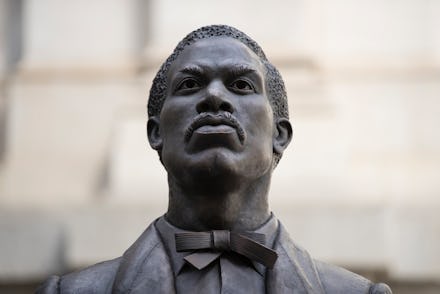Push for more African-American monuments grows amid Confederate statue controversies

Grassroots movements to get rid of Confederate statues in public spaces across the United States continue to grow.
Calls for more monuments recognizing the contributions African-Americans have made to the nation’s history may be increasing as well, according to award-winning sculptor Branly Cadet.
The 52-year-old artist’s latest piece depicting 19th century Philadelphia renaissance man Octavius V. Catto, was unveiled Tuesday outside Philadelphia City Hall after 15 years of development.
Catto was a renowned educator, National Guard major, athlete and civil rights activist born in 1839 who led the movement to desegregate the historic City of Brotherly Love’s streetcars and establish voting rights for local African-Americans.
Catto was shot and killed at age 32 by a local Irish man amid racially tense street violence on Election Day in 1871.
Philadelphia Mayor Jim Kenney, who is white, has been fighting for 15 years to have Catto recognized in a public space after first learning of the oft overlooked “true American hero” when reading about the city’s history.
“What struck [Kenney] was, ‘How did I never hear of this guy O.V. Catto?’” memorial fund spokesman Martin O’Rourke told Mic by phone. “At that point, he just wanted to hear more.”
The approximately 11.5-foot, 800-pound bronze sculpture of Catto stands on a granite base and an insularly block topped off by a rendition of a stainless steel ballot box, according to O’Rourke and Cadet.
The monument also features five granite pillars representing the street cars Catto worked to desegregate, both men said.
Cadet is an Oakland, California, resident originally from New York who also built the bronze sculpture of Harlem civil rights icon Adam Clayton Powell, which was released in 2005.
His other recent work depicting baseball pioneer Jackie Robinson was unveiled in April at Dodger Stadium in Los Angeles. Since then, Cadet said he’s been tapped for possible work on three developing projects depicting African-American heroes, about the same amount of potential work honoring black trailblazers that he’s received in the previous decade.
“Some of the requests are more contemporary than others,” Cadet said in a phone interview regarding the potential new projects, declining to discuss pending details. “It’s great we’re looking at the value of having these in public spaces.”
In 2016, there were 718 Confederate monuments still standing across the United States, according to the Southern Poverty Law Center.
National Sculpture Society executive director Gwen Tier said the number of African-American monuments across the United States is far less, but that’s changing quickly.
“The number of monuments to African-American heroes is going up fairly rapidly and will probably surpass the other,” Tier said. “It’s been discussed a lot, with all the Confederate monuments coming down in the south, which I think is good.”
The Smithsonian Institute opened the nation’s African-American History Museum in Washington D.C. on Sept. 24, 2016.
The National Parks Service unveiled its Martin Luther King Jr. Memorial in the nation’s capital in August 2011.
Historical reflection is often the argument used for keeping Confederate monuments in public spaces, which is ironic since there are relatively much fewer public monuments dedicated to black Americans, whose stories are often treated as an elective rather than part of the main curriculum of U.S. history, O’Rourke said.
“It’s up to each city to make those decisions,” he said. “African-Americans are part of American history and they haven’t been recognized as such. Hopefully moving forward they will be.”